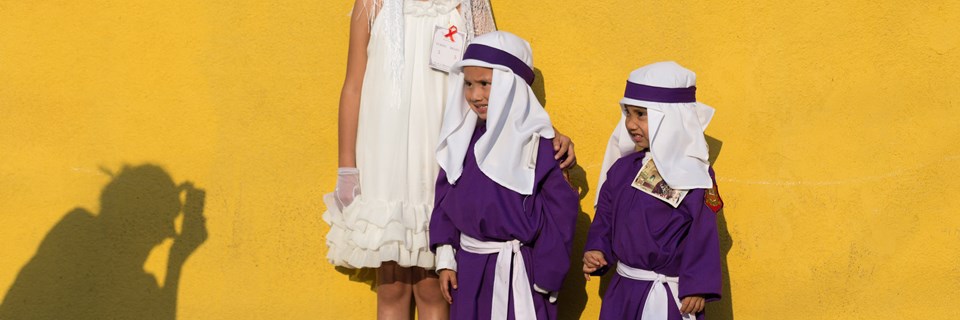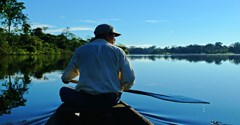Planning to visit Latin America around Easter for late May? You might consider timing your visit to take in the spectacular Semana Santa and El Gran Poder celebrations.
Semana Santa (Holy Week) is celebrated throughout Latin America and is widely acknowledged to be the most important catholic festival of the year in the region. The week pays tribute to the Passion of Jesus Christ, the time of suffering before his crucifixion and death, and many countries re-enact the various stages of this through street parades.
The festivities, which begin on Palm Sunday and end the day before Easter Sunday, are a mixture of solemnity and reflection and colourful parades and celebrations, particularly towards the end of the week. The customs vary from country to country, as you will find out below, but travellers visiting during this time can enjoy a privileged and often moving insight into local culture and food and a greater understanding of the role religion plays in everyday life. As you might expect, the week is usually extremely busy and many business will close, so you must be prepared for this and book as far in advance as possible to secure hotel reservations.
Let's have a look at some of the best places to attend Semana Santa in Latin America and what you might expect from each.
El Gran Poder, La Paz, Bolivia
The Festival of the Gran Poder is a celebration of Catholic traditions mixed with Aymara customs. All participants in the parade make a promise to the Lord, committing themselves to dance for three consecutive years so ensure their wishes come true. This promise is accompanied by a ceremony to the Pachamama (Mother Earth) where objects made of sugar are burned as an offering to request protection during the celebration of Gran Poder and for daily life. The celebrations occur, not at Easter, but at the end of May and early June each year when La Paz is transformed into 2 days of joyful reverence to Lord Jesus the great power.
The procession is enormous, with over 25,000 dancers, musicians, performers and devotees slowly making their way from the western part of La Paz to the city centre, arriving at the church of San Antonio. An excitable atmosphere full of colour resonates, with dances from the Morenos, native dances from Sikuris and Qhantus and wonderful musical entertainment. On the second day of the festival, the procession continues as the patron saint is carried all the way to the Gran Poder district of La Paz. Here devotees pay tribute to oLd Jesus the Great Power with flowers, confetti and incense.
We recommend observing both days of the festival, either as an onlookers on the street or taking a seat in a grandstand set up along the procession.
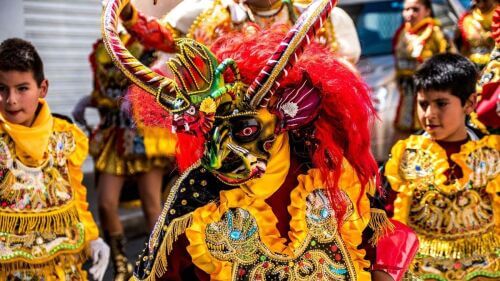
Guatemala - Antigua
Perhaps the Latin American city most synonymous with Semana Santa is Antigua in Guatemala. The picturesque city provides a wonderful backdrop to the celebrations, with the Volcán de Agua standing tall above the cobbled streets and Spanish Mudéjar baroque architecture. Typically beginning on Ash Wednesday, the processions here are thought to be among the most spectacular in the region, often lasting all day. But Antigua is best known for its incredible alfombras; large colourful carpets made from coloured sawdust and flowers which stretch out along the ancient streets. These are then destroyed when the purple-robed participants holding floats, crosses and statues of Jesus Christ walk along them in the spectacular processions.
Where to combine with Antigua: The other highlights of Guatemala include the nearby thriving Indian market of Chichicastenango, the tranquil Lake Atitlan and its traditional communities and the powerful Mayan pyramids of Tikal, buried deep in the rainforest.
 Peru - Arequipa & Cusco
Peru - Arequipa & Cusco
Peru's two most attractive cities and major tourism centres are also two of the best places to experience Semana Santa in South America. The 'White City' of Arequipa, known for its attractive colonial mansions and churches and its proximity to the breathtaking Colca Canyon, makes for a great base for a few days. During Semana Santa, the main 'action' takes place in Paucarpata, a short drive out of the city centre, where the celebrations revolve around the Vía Crucis on Good Friday. The enactment recounts the stages of life, passion and death of Christ in other 50 carefully choreographed scenes involving over 200 local actors. It is a highly professional and detailed undertaking and draws many thousands of spectators each year.
A key component of the Semana Santa celebrations in Cusco, the former Inca capital, is the procession dedicated to Señor de los Temblores. This small statue of a crucified Christ resides in Cusco Cathedral, in the very centre of the city. When disaster struck in 1650 and the city was hit by a devastating earthquake, a local took the statue out of the cathedral and almost instantly the ground stopped shaking. To celebrate this miracle, the Lord of the Earthquakes is paraded around the streets of central Cusco as part of the Holy Week festivities.
Where to combine with Arequipa: The White City is located in the south of Peru, close to the spectacular Colca Canyon, where you are also able to get up close to wild Andean Condors. Another popular combination is a memorable flight over the ancient Nazca Lines, carved into the southern deserts centuries ago.
Where to combine with Cusco: The former Inca capital is best visited as part of a trip which includes the nearby Sacred Valley, where we find hilltop Inca ruins, remote Andean communities and vibrant local markets, and Machu Picchu; the lost Inca citadel perched high above a river gorge amid cloud forest.
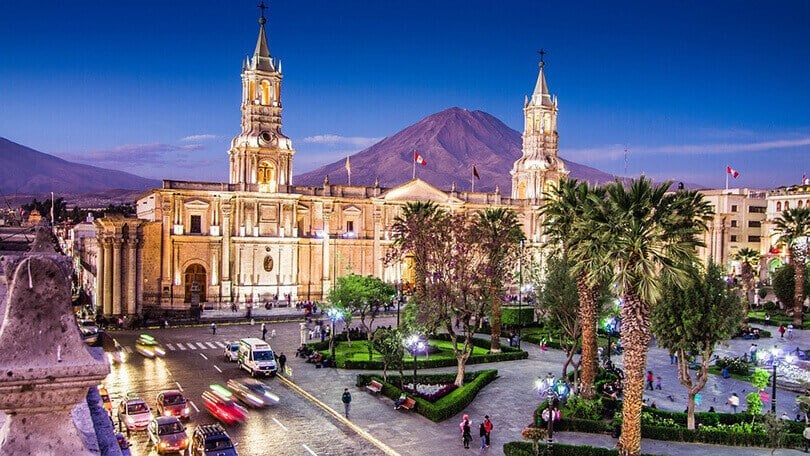 Central Arequipa at night
Central Arequipa at night
Brazil - Ouro Preto
Ouro Preto is the principal city of the Minas Gerais region, where we find a number of cities and towns which thrived during the Brazilian Gold Rush. Timeless cobbled streets are lined with sumptuous colonial era mansions, leading to magnificent baroque churches, adorned with the works of Aleijadinho, one of Brazil's foremost sculptors. It is a magnificent backdrop for the celebrations.
During Semana Santa, Ouro Preto follows the lead of other cities, such as Antigua, in creating colourful carpets depicting religious themes, made with sawdust, flower and even coffee. These create a long pathway to be followed during the magnificent processions between churches. Other features of the Holy Week include religious music concerts, professionally produced shows depicting the Passion of Christ and local art exhibitions, in addition to the elaborate washing of the feet ceremony, re-enacting the moment that Christ washed the feet of the twelve apostles.
Where to combine with Ouro Preto: As well as the other cities of Minas Gerais, you might like to combine your trip with visits to the exotic Afro-Portuguese city of Salvador and the iconic beaches and monuments of Rio de Janeiro and discover Brazil's natural side in the Amazon Rainforest or the wildlife haven of the Pantanal.
 Semana Santa in Ouro Preto, Brazil (photo by Ana_Cotta)
Semana Santa in Ouro Preto, Brazil (photo by Ana_Cotta)
Colombia - Popayán & Mompox
Popayan is the second 'White' city to appear on this list, following on from Arequipa in Peru. Located a short flight south of Bogota, Popayan is an otherwise sleepy colonial town dominated by church steeples, but which comes to life during Semana Santa as it hosts one of the Colombia's most renowned celebrations. Huge numbers flock to see the impressive processions as they edge their way through the streets, whilst art also plays an important part of the festivities here, with a number of exhibitions and events in the centre.
In the north of Colombia is the town of Mompox, another place closely associated with Semana Santa. The centrepiece of the celebrations is actually a deeply symbolic and moving affair. In scenes more reminiscent of the Day of the Dead in Mexico, residents in their finest dress proceed through the streets on Wednesday evening and adorn the graves of departed loved ones with flowers.
Where to combine with Popayan & Mompox: A visit to either would be best added on to a Colombia holiday which encompasses the thriving capital Bogota, surrounded by the Andes, the beautiful Caribbean city of Cartagena and perhaps the coffee plantations of Pereira, the wax palm trees of Cocora Valley and the boulder-strewn beaches of Tayrona
 Popayán, Colombia (photo by Feliperma15)
Popayán, Colombia (photo by Feliperma15)
Ecuador - Quito
One of the continent's biggest and most spectacular series of parades takes place in the Ecuadorian capital Quito. The city itself is surrounded by high Andean peaks and boasts a beautiful UNESCO listed city centre, where we find some of the grandest and most richly decorated churches of South America.
The Semana Santa celebrations bring hundreds of thousands of locals and visitors out onto the streets to witness the parades. Featuring heavily on Good Friday are the purple-robed cucuruchos - males who carry the floats and fill the streets during the parades. The term is related to the large cone-shaped hat which forms part of their distinctive attire, donned by devout sinners in colonial times during periods of self-imposed suffering in the streets and against the elements. Today it is seen as an act of faith and humility and a symbol of remorse for the mistakes of mankind.
Other interesting Semana Santa customs include the dressing up of devils by around twenty men in Alangasi, who are then subsequently 'banished' from the church and also the symbolic Arrastre de Caudas. Unique to Quito, this custom was first performed in the 16th century and has its origins in Roman times. At midday a large black flag with a red cross is dramatically dragged into Quito Cathedral in a ritual which commemorates the death of Jesus, with the cape passing his virtues on to the congregation as it makes its way around the cathedral.
Where to combine with Quito: As the natural entry point into Ecuador, Quito can easily be combined with cruises in pristine areas of the Amazon Rainforest and to the wildlife-rich volcanic islands of the Galapagos archipelago. Nearby is the vibrant Otavalo Market, whilst the spectacular Avenue of the Volcanoes leads south towards the attractive colonial city of Cuenca, famed for its Panama hat industry.
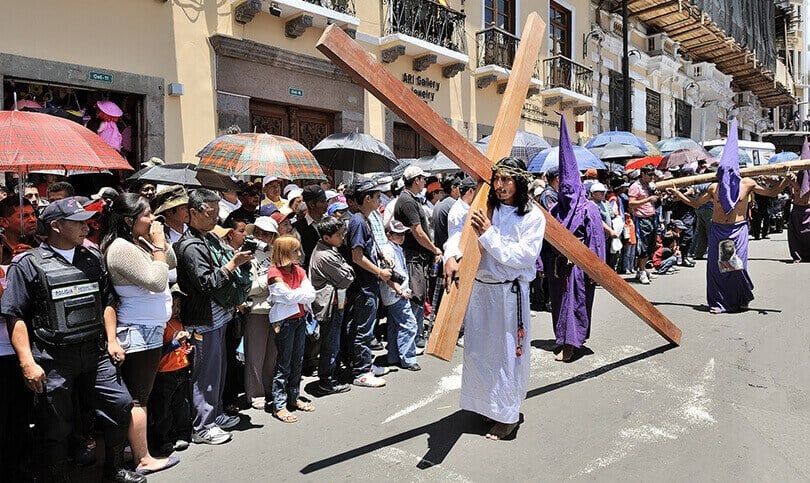 Semana Santa procession in Quito, Ecuador (photo by Cayambe)
Semana Santa procession in Quito, Ecuador (photo by Cayambe)
Mexico - Central Mexico
Last but not least we return to Central America and to the very heart of Mexico. In the colonial hillside towns and neighbourhoods surrounding the capital Mexico City and in culturally-rich cities further east, Mexico embraces Semana Santa with the same sort of enthusiasm and reverence reserved for the emblematic Day of the Dead celebrations.
Sat 2,240 metres above sea level, upon the foundations of the former Aztec city of Tenochtitlan, Mexico City is the ideal base from which to explore the centre of the country. Within easy reach are a number of attractive colonial era towns and small cities, including Cuernavaca, Taxco, San Miguel de Allende and Puebla, all of which welcome visitors to enjoy their elaborate processions.
Closer to the capital is Iztapalapa, one of the 16 districts of Mexico City. It is here that millions of people are thought to attend or participate in the epic Passion Plays re-enacting the cruxification of Christ. What makes the Pasión de Cristo different here is that it has its roots in the cholera epidemic of 1833, which wiped out around 5% of the population in Mexico City. Desperate residents proceeded en-mass to the Santuario de Señor de la Cuevita to implore an image of Christ entering Jerusalem to end the suffering in exchange for an annual procession in his honour. Just eight more people died from the outbreak. This and other 'miracles' feature heavily in the many scenes of the procession dedicated to the life and death of Christ, including the feeding of the 5,000, the Last Supper, the Stations of the Cross and the betrayal of Judas. Hundreds of actors and extras take part, as well as some 2,000 cross-bearing 'Nazarenes'.
Where to combine with Central Mexico: The places mentioned above can be easily combined with the cities of Oaxaca and San Cristobal de las Casas or you might prefer to experience Semana Santa in these cities instead. Central Mexico is often combined with the Caribbean beaches, the jungle-bound Mayan pyramids and attractive colonial cities of the Yucatan Peninsula.
 Semana Santa in Ozumba, Central Mexico (photo by MGM25)
Semana Santa in Ozumba, Central Mexico (photo by MGM25)
As you can see from the above, there are a number of wonderful places to experience the colour, rituals and passion of Semana Santa in Latin America. These examples represent some of the most interesting celebrations in rewarding and popular cities, towns and regions. There are however hundreds of other destinations which create real spectacles and have their own deeply-rooted traditions. If you would like to incorporate a few days to attend Semana Santa in Latin America into your holiday next spring, then we'd love to chat through your options and discuss your travel plans with you.
Choose your perfect holiday
Find inspiration from our selection of itinerary suggestions, a great starting point for your next trip
View More Tours
Stay in touch
Infuse your travels, with inspiration from our monthly newsletter.
READY - 20 April 2024
LANDMARK TOURS: Multi-Country & Cross Continent. New Cosmopolitan Tour: Buenos Aires, Iguazu, Rio
CHINA & INDIA: Local Life, People & Unique Cultures
GUIDES by Veloso Tours, are the best Local Hosts
PRIVATE VILLAS: Quality Time in exclusive settings
TRAVEL INSURANCE with extensive COVID-19 cover
